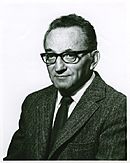Sol Spiegelman facts for kids
Quick facts for kids
Sol Spiegelman
|
|
|---|---|

Sol Spiegelman
|
|
| Born | December 14, 1914 |
| Died | January 21, 1983 (aged 68) |
| Nationality | American |
| Alma mater | City College of New York, Washington University in St. Louis |
| Known for | nucleic acid hybridization, Spiegelman's monster experiment |
| Scientific career | |
| Fields | Molecular biology, genetics |
| Institutions | University of Illinois at Urbana-Champaign, Columbia University |
Sol Spiegelman (born December 14, 1914 – died January 21, 1983) was an American scientist. He was a molecular biologist, meaning he studied the tiny parts that make up living things. He created a special method called nucleic acid hybridization. This method was very important for making new tools in science, especially for working with DNA and RNA.
Contents
Early Life and Education
Sol Spiegelman was born in Brooklyn, New York City, in 1914. He went to the City College of New York. At first, he was interested in biology. But the classes didn't excite him much. So, he decided to study math and physics instead.
While in college, he took a break to work in a lab. There, he learned about the genetics of bacteria, which are tiny living things. He finished college in 1939 with a degree in mathematics.
In 1940, he started studying at Columbia University. He focused on how cells work, guided by Professor H.B. Steinbach. Two years later, Spiegelman moved with Steinbach to Washington University in St. Louis. He earned his PhD from there in 1944. His research looked at how cells change their behavior based on their environment. This is now known as changes in gene expression. He stayed at Washington University until 1948. Then, he spent a year at the University of Minnesota.
Academic Career and Discoveries
In 1949, Spiegelman joined the University of Illinois at Urbana-Champaign. He worked there for 20 years. His research focused on nucleic acids, like DNA and RNA. He also studied the enzymes that help make these nucleic acids. He worked with viruses called bacteriophages, especially those with RNA as their genetic material, like bacteriophage Qβ.
One of his most famous experiments involved Qβ RNA. He showed how RNA could copy itself in a test tube. This led to something called Spiegelman's Monster. It was a simple RNA molecule that could reproduce on its own.
Spiegelman's best-known work was on nucleic acid hybridization. This method helps scientists find specific DNA or RNA sequences. It was a huge step forward for recombinant DNA technology. This technology allows scientists to combine DNA from different sources.
Later, in 1969, Spiegelman moved to Columbia University. He became a professor of human genetics. He also directed the Institute of Cancer Research. He was very interested in whether viruses could cause cancer. In 1975, he was named a University Professor.
Awards and Honors
Spiegelman received the Lasker Award in 1974. This was for his important work on Qβ RNA from 1965. In 1981, he won the Feltrinelli Prize in Biology. This award recognized his contributions to molecular biology. He was also elected to the National Academy of Sciences in 1965. A year later, he joined the American Academy of Arts and Sciences.
Personal Life
Sol Spiegelman and his wife, Helen, had three children. He passed away in 1983 from pancreatic cancer.
See also
 In Spanish: Sol Spiegelman para niños
In Spanish: Sol Spiegelman para niños

